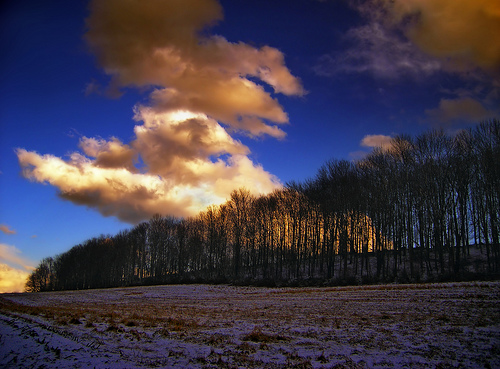Welcome to the second installment in our series on how small, individual efforts can positively contribute to flood and drought mitigation. While much attention had been paid to community scale mitigation projects and methods, individuals can still play a role in mitigating floods. Although one person cannot hold back the entirety of future flood waters on their own, engaging in any number of small acts can make some of a difference, especially in smaller scale events.
Engineer Your Garden or Yard
In the 1990s, a group of farmers from Pontbren, England decided to forgo their usual hill farming strategy, which relied on digging ditches and removing hedges or trees. Instead they began to plant shelterbelts and build ponds. Studies found the water in Pontbren was channeled into the ground by (the newly added) tree roots and that the soil under trees acts as a sponge absorbing water 67 times faster than the soil under grass[1][2]. Even more impressive is that the tree soil acts as a reservoir and released water very slowly. If all Pontbren farmers opted for reforestation one study found that peak flooding downstream would be reduced by about 29% and full reforestation would reduce peak flooding by 50% downstream.
 |
|
A shelterbelt (also known as a windbreak) is made up of one or more rows of trees and are used to reduce wind and erosion. Photo: “Divided” by Nicholas A. Toneli is licenced under CC BY 2.0. |
Many of the ideas implemented in Pontbren can be applied on a smaller scale in your yard or neighbourhood. One very simple flood mitigation act is to plant more trees or shrubs on your property. If you don’t have room for a tree, you can plant moisture loving vegetation near downspouts so water can soaked up before it enters storm drains. Rain gardens are a useful and beautiful addition to any yard as they also soak up and help to filter water before it drains away. If you would also like to mitigate your yard against drought you can research local varieties of trees and plants that are well adapted to the wet and dry conditions of Alberta.
If you are interested in aligning your yard or neighbourhood green spaces with nature, you might want to learn more about permaculture. Permaculture is a type of ecological engineering which works with nature to create and maintain an agriculturally productive ecosystem that is as diverse, stable and resilient as a natural ecosystem[3]. Permaculture focuses on growing food and endeavors to create a “harmonious integration of natural systems with human habitat and land use”[4]. There are many permaculture specialists in Alberta and online resources available for beginners. Although the process can be very involved, you can implement aspects of the philosophy into your landscape.
Depaving parts of your property
Depave Paradise is a group that works to remove unwanted asphalt and create green more spaces. When it rains water rushes over impervious surfaces like concrete, pavement and asphalt before being channeled into storm drains. With enough rain and debris, these storm drains can become overwhelmed and water is prevented from draining. Alternatively, it can make a bad problem worse for those located where the storm drains exit. If pavement is replaced with certain types of gravel or grass, some of the water will be diverted away from storm drains and can be absorbed into the ground. Replacing pavement on your property with trees or shrubs can prevent water from rushing into storm drains. If you don’t have a yard, you can volunteer at a local depaving event.
Visit the Green Calgary website to learn more about the depaving event happening on July 20th.
[1] M. R. Marshall, C. E. Ballard, Z. L. Frogbrook, I. Solloway, N. McIntyre, B. Reynolds, & H. S. Wheater. (2013). The impact of rural land management changes on soil hydraulic properties and runoff processes: results from experimental plots in upland UK. Hydrological Processes 28,(4), 2617–2629. Retrieved from http://onlinelibrary.wiley.com/doi/10.1002/hyp.9826/abstract
[2] G. Monbiot. (2014, January 13). Drowning in money: the untold story of the crazy public spending that makes flooding inevitable. The Guardian. Retrieved from www.theguardian.com
[3] Growing food Secure in Alberta. Pernaculture in Alberta. Retireved from http://www.foodsecurityalberta.org/node/35
[4] Big Sky Permanculture. Permaculture. Retrieved from http://www.bigskypermaculture.ca/node/1
